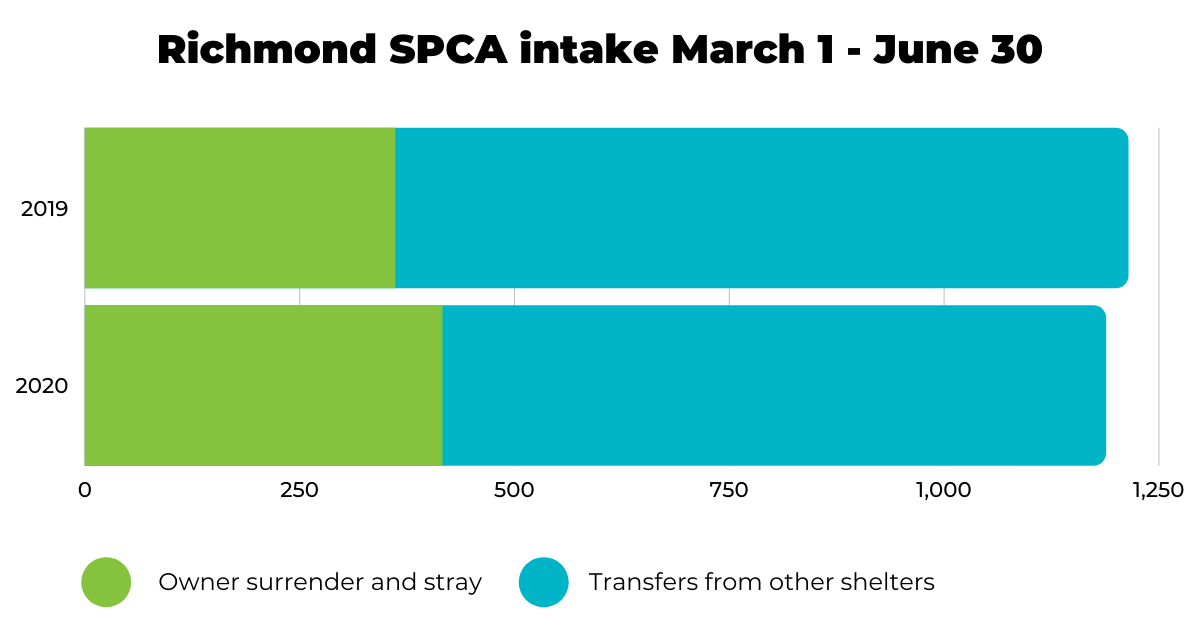What we can learn from shelter intake and adoption trends during the pandemic

Months ago, as shelter-in-place orders began blanketing much of the country, dozens of news stories described surging pet adoptions—a welcomed silver lining amid all the disturbing COVID-19 reports. As more people found themselves sequestered in their homes and in search of companionship, many opened their hearts—and their newfound pandemic bubbles—to pets awaiting adoption in humane centers like ours. In mid to late March, while the Richmond SPCA was reimagining much of our adoption process in a new virtual environment, our adoptions grew by about 6 percent over the prior year, and in the first three weeks of our modified operations under COVID-19, we sent 169 pets home with adopters.
Simultaneously, another positive national trend in animal sheltering was developing as a result of the public health emergency. As adoptions increased in those early weeks of COVID-19, the number of homeless dogs and cats entering shelters started to decline amid continued quarantine efforts. Shelter Animals Count (a national database of sheltered animal statistics) issued a COVID-19 Impact Report earlier this summer containing comparative data from 1,270 animal welfare organizations across the country. The report showed that 548,966 pets entered those combined organizations in March through June 2020 compared to 840,750 during the same period the prior year—a reduction of 35 percent. Government shelters saw the largest decline in overall intake (40 percent) compared to private shelters and rescues (23 percent). During the same period at the Richmond SPCA, our overall intake also declined, but by a lesser amount (2 percent), and the entire reduction was owing to the decreased intake at government shelters from which we transfer pets into our care.
Early increases in adoption coupled with sustained decreases in intake resulted in an improved live release rate for homeless animals nationwide. According to the same Covid-19 Impact Report from Shelter Animals Count, 89 percent of homeless dogs and cats left shelters alive from March through June 2020 compared to 86 percent during the same period in 2019. To put this in better context—tens of thousands fewer homeless dogs and cats lost their lives across the country this spring compared to last.
This is excellent news, and data worthy of much celebration. But while we celebrate, we know that our important work is far from done. Vulnerable animals in our own community and across the country are depending on two important factors to sustain the lifesaving momentum of the past several months:
- Investments in shelter diversion programming. An essential ingredient to reducing intake of dogs and cats in animal shelters is shelter diversion (programs designed to keep pets in loving homes and out of shelters). As the old saying goes—an ounce of prevention is worth a pound of cure. And to cure animal homelessness, we must continually invest in programs that address the root causes of that homelessness. This is how we move the needle of lifesaving forward—and keep it there. At the Richmond SPCA, we have been creating and providing shelter diversion programs for more than two decades. These services have included high-volume free and low-cost spaying and neutering, free pet behavior support via our Behavior Helpline, free pet food assistance through our Pet Pantry, temporary low-cost boarding, pre-adoption microchipping, Trap-Neuter-Return for community cats, full-service, low-cost veterinary care in our Susan M. Markel Veterinary Hospital and more. During the pandemic, we have seen increased demand for many of these services as pet guardians struggle with added financial and housing insecurities brought on by the pandemic. Your support of crucial shelter diversion programs assures we can meet the growing needs that exist for pets and the people who love them.

Adopt locally instead.
- Prioritizing adoptions. The puppy mills that supply pet stores and online sellers have seen the pandemic as an unprecedented opportunity. As the number of homeless animals in shelters has declined in recent months and as demand for adoption has stayed the same or increased in parts of the country, pet stores and online sellers have been marketing their puppies like never before. Don’t fall for it. Just before the public health emergency started impacting Central Virginia, we launched a puppy mill education campaign, and these important messages are especially relevant during these extraordinary times. Pets in humane centers like ours are relying on your continued commitment to adoption. With a little time and patience, you will find just the right companion at an animal shelter. Please give us the opportunity to help you meet your match.
Across our region and the United States, compassionate and dedicated friends to animals have stepped up in big and important ways to help ensure COVID-19 did not create a simultaneous crisis for animals from forming. But the fight is not over. And I know we can continue to count on your support to achieve more progress for the animals who need us throughout the remainder of this pandemic—and beyond.

As the CEO of the Richmond SPCA, Tamsen Kingry oversees the development of our organization’s short- and long-term strategies to achieve maximum lifesaving and fulfill with integrity the Richmond SPCA’s mission.
When she’s not busy working alongside our talented and dedicated staff, Board and volunteers, Tamsen enjoys spending time with her husband and daughter, as well as their two cats and a dog—all of whom they adopted from the Richmond SPCA.




